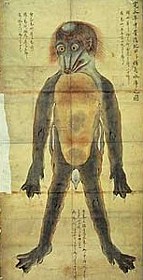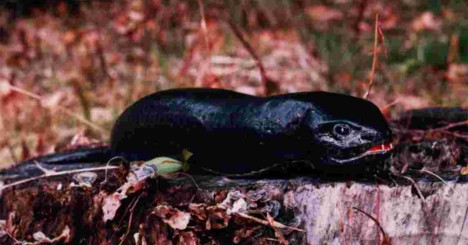Tsuchinoko: 100 Million Yen Reward
Posted by: Loren Coleman on June 6th, 2008
Times have been rather hectic lately with the recent news of the Bigfoot “massacre” theory, the Bigfoot trail camera photo prize, and the Pepie challenge money. Therefore, I did want to acknowledge an item published over at the Pink Tentacle a few days ago.

The essay was entitled “Seven Mysterious Creatures of Japan”. It is worth your reading, especially if you are not familiar with the Hibagon (unknown anthropoid), Kusshii (lake monster), Isshii (lake monster), Giant Snake of Mt. Tsurugi, Takitaro (giant fish), Kappa (merbeing, shown above), and Tsuchinoko.

Specifically, I wished to point to the Tsuchinoko paragraphs, as a new expedition is being planned in two days, for June 8, 2008, to search for this well-known Japanese cryptid. As with two other bits of news I shared recently, this one on the Tsuchinoko is tied to a reward for the creature.

Here is what the Pink Tentacle has to share:

The Tsuchinoko is a snake-like cryptid found throughout Japan, except in Hokkaido and the Okinawan islands. Reports describe the Tsuchinoko as having a thick, stubby body measuring 30 to 80 centimeters (12 to 30 in) in length, often with a distinct neck, gray, brown or black scaly skin, and venomous fangs. Some accounts suggest the Tsuchinoko has a loud, high-pitched squeak and can jump as far as one meter.
The earliest known written record of the Tsuchinoko dates back to the 7th century, where it appears in the Kojiki (Records of Ancient Matters), the oldest surviving book in Japan. In some legends, the Tsuchinoko can speak, has a tendency to tell lies, and enjoys the taste of alcohol.

Skeptics dismiss Tsuchinoko sightings as simple cases of mistaken identity, suggesting the creatures are nothing more than snakes in the process of digesting large meals, or perhaps even escaped exotic pets such as the blue-tongued lizard.
Regardless, local tourist boards in rural areas frequently organize Tsuchinoko hunts to attract visitors, promising large sums of money to any participant lucky enough to capture one. The town of Itoigawa in Niigata prefecture, for example, has a hunt scheduled for June 8, 2008 and is offering a 100 million yen (about $1 million) reward to whoever brings one back alive. [More here, if you read Japanese.]
About Loren Coleman
Loren Coleman is one of the world’s leading cryptozoologists, some say “the” leading living cryptozoologist. Certainly, he is acknowledged as the current living American researcher and writer who has most popularized cryptozoology in the late 20th and early 21st centuries.
Starting his fieldwork and investigations in 1960, after traveling and trekking extensively in pursuit of cryptozoological mysteries, Coleman began writing to share his experiences in 1969. An honorary member of Ivan T. Sanderson’s Society for the Investigation of the Unexplained in the 1970s, Coleman has been bestowed with similar honorary memberships of the North Idaho College Cryptozoology Club in 1983, and in subsequent years, that of the British Columbia Scientific Cryptozoology Club, CryptoSafari International, and other international organizations. He was also a Life Member and Benefactor of the International Society of Cryptozoology (now-defunct).
Loren Coleman’s daily blog, as a member of the Cryptomundo Team, served as an ongoing avenue of communication for the ever-growing body of cryptozoo news from 2005 through 2013. He returned as an infrequent contributor beginning Halloween week of 2015.
Coleman is the founder in 2003, and current director of the International Cryptozoology Museum in Portland, Maine.










Overall, this is definitely one for the herpetologists – the illustrations look like a strange combination of frog, snake, lizard and turtle. Perhaps it is a legless “pygmy dragon”?
The reference suggesting its anti-teetotaler tendency to telling tall tales does sound a bit bizarre, but ascribing human traits to animals (both proven and mythological) in ancient stories, are not uncommon and that aspect of it should probably not be taken too seriously.
I just hope that million dollar incentive does not cause too much problems or disturbance (that is, if they still exist).
Ah, now if I could only get to Japan. Interesting thing, the gray photo looks a little short for a snake that is digesting its food. The relation of the size of the head with the rest of the body. And, I know snakes can digest rather large critters, but I do think they tend to find things that are more manageable. Not that they can’t suck down something almost as big as itself, but that they generally prey on things that are, well, like I said, smaller and manageable.
The overall appearance suggests a skink, and I believe some members of that lizard group have lost their legs. But it’s not clear how such a stout creature would move on land without legs, or only rudimentary ones. Or is it said to be aquatic?
Ya know, folks, everything described here sounds very much like the serpent in Genesis. After all according to Moses (writing down the oral traditions) the serpent lost its legs and was forced to move on its belly. Many have suggested that this is the tale of the beginning of snakes, but they tend to forget that it is suppose to be a very beautiful animal. Sorry, but the folklore of this one talking and telling lies hit home. From an evolutionary standpoint, any animal that finds faster/easier way to move around would probably lose use of their legs (first) and then lose them altogether. Although, if the illustrations above are correct, I don’t see the loss of legs as much as the loss of the use of fins. Japan has some weird animals that science just can’t explain. Like the Akita, dog. Very feline in many ways, but a definite canine. The legends say that the first Akita was the result of breeding a dog with a large cat (of some sort). Almost sounds like science fiction tampering with the DNA.
Man I disagree with the snake digesting and animal theory in regards to the grey photo (video still?). The body is too tiny compared to the head in that case, at least in terms of any snakes known in Japan. You can also see stubby protrusions in the front and back, right where the legs of a lizard would be. Seems just as likely to be an unknown reptile than to be a rather deformed snake in mid-digestion.
Oh yeah the Kappa is one of my favorite creatures. Those recent reports are pretty spooky.
Seems 2008 is the year of money-making cryptocampaigns… not that there’s anything wrong with that 🙂
Folks, the photo looks way too much like a known lizard, in fact the one suggested, right below the photo: the blue-tongued skink.
Upon viewing that last picture, Skink was the first thing to come to my mind. The first picture on the other hand, not sure (not the kappa picture, so technically the second picture in the article).
What if its just a new species of skink?
The tsuchinoko, one of the classic Japanese cryptids. I’ve seen lots of photos of supposed tsuchinokos, but the one here is a new one for me. I don’t know how much stock I put in its authenticity, but it is interesting nonetheless. Looks to me like a type of skink that’s had a little too much to eat or is just plain fat. Skinks have pretty small legs in relation to their bodies, and it looks to me as if this one’s legs could be held close to the body and folded under.
There have been some supposed tsuchinokos that turned out to be just that, an overfed snake or lizard, so it is not a possibility that can be ruled out. However, these snakes are supposedly able to leap over a meter which is something that would be extremely odd for a recently fed snake or lizard. Also, some people aren’t aware of the amazing variety of vocalizations attributed to the tsuchinoko, such as whistles, chirping, even alleged mimicry of human voices, which do not match anything in the known snakes or lizards of Japan.
That link is pretty interesting. I’ve lived in Japan for 13 years and thought I knew all of the Japanese cryptids, but there are two there that I’ve never heard of. The Takatori giant fish and that giant snake. Cool.